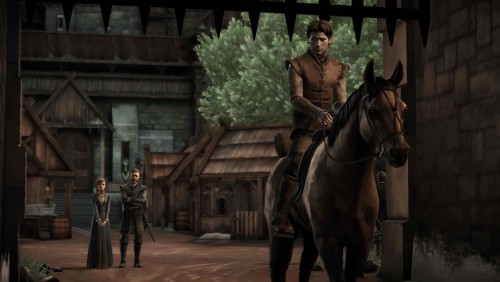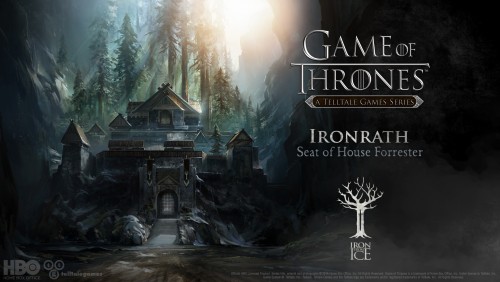Westeros
The 'A Song of Ice and Fire' Domain
Features
The newly released first episode of the Game of Thrones adventure game from Telltale Games—a company that’s been around since 2004, creating adventure games of all sorts, but which only fairly recently rose to prominence with the critical acclaim for its The Walking Dead game—has certainly drawn some attention. Reviews have varied (see Polygon at one end, IGN at another, and Rock, Paper, Shotgun is always worth reading) but everyone certainly seems to feel that they’ve captured something of the Game of Thrones TV series in its tone and style (even if, in certain areas—the sexual content, namely—it’s toned way down [so far]).
I myself have had a little experience of Telltales’ games, but from their pre-TWD period when the games they produced (such as the licensed Back to the Future and their first episodic title, Sam and Max: Season One). These were much more traditional adventure games, and were solid-to-pretty good. But the real boom of success that The Walking Dead brought—a success that has led to their Fables: A Wolf Among Us game based on Bill Willingham’s comic book series, and more recently Tales of the Borderland based on the popular FPS—was also paired with a very different approach to the adventure game. At the outset, Telltales Games made very traditional adventure games. No surprise there, really: several members of the company came there by way of Lucasarts, famous for its adventure games such as The Day of the Tentacle, Sam and Max Hit the Road, and the Secret of Monkey Island series among others. Those games generally featured a lot of puzzles, and while they had strong central narratives you had relatively little control over it. You might end up with two or three different end states, with some minor variations in the mechanics of how to get from point A to point B, but your character’s interactions would have little lasting impact in terms of the dynamics of character relationships. The characters would generally always think of you in the same way, regardless of what you did.
With The Walking Dead and its subsequent games, however, Telltales moved away from games that were very much about inventory and logic puzzles, and instead focused much more on character. Character interactions would be of paramount importance in determining the several (predetermined) end points, with significant character choices along the way determining the branching of the main plot and various minor sub-plots. This character-driven approach suited The Walking Dead very well. And if it sounds like it might suit Game of Thrones, you’re not wrong, because Telltales’ first episode (note: Telltales provided us a review code for the game) is a solid start that introduces the key players in the game while weaving the narrative through a key event (the Red Wedding) which acts as the real launch point of the story. What follows is an example of the aftermath as experienced by one minor family in the north. The Forresters are presented as the Lords of Ironrath, a small seat sworn to House Glover of Deepwood Motte, and their chief claim to fame is the ironwood that they harvest and craft. With the fall of Robb Stark—the narrative mostly takes place between the third and fourth seasons—they are left in the difficult position of dealing with the ascension of the Boltons to Wardens of the North.
Just as in the source novels, the game moves among several “point of view characters”, all of them members of the Forrester household. The device works reasonably well, although one of the areas where the show is often weak (consistent sense of time and distance) raises its head here as characters make extremely rapid journeys over hundreds of miles, and messages seem to flit back and forth between the North and King’s Landing in just a couple of days. Clearly, Telltales subscribes to Benioff’s and Weiss’s “speed of plot” approach to travel. The voice acting ranges from acceptable to quite good, while graphically speaking the game won’t leave anyone agape but it’s serviceable. Of particular note is a “watercolor” effect on background scenery which allows for the occasional excellent vista, although minor graphics glitches which appear here and there in the game include the failure to apply the watercolor filtering.
Questions have arisen regarding the level of “canon” information in the game. While the game itself is not part of the A Song of Ice and Fire canon, it fits within the Game of Thrones continuity (at least notionally). But given that George R.R. Martin’s former assistant Ty Franck was a story consultant, there’s some who might wonder if the new details regarding the Forresters, their seat of Ironrath, their rivals the Whitehills, and the value of ironwood come from GRRM by way of Franck. We can’t answer that question authoritatively, but certainly House Whitehill has never appeared anywhere but in our Heraldry section (you can see the Whitehill arms), where we presented the heraldic arms that George sent to us in various notes. But everything else—their location, their seat, their associations—are unknown to us. Could they be neighbors of the Forresters? Certainly. Could they also be vassals of the Boltons, nearly on the opposite side of the North? Certainly, as we have some examples of non-continguous domains in the books (the Royces of Runestone have the Coldwaters of Coldwater Burn as vassals, the village of Pennytree in the riverlands is part of the royal demense), so it’s not implausible that some Bolton lord was granted land in the wolfswood and this in turn was passed off to a Bolton vassal.
But what about the Forresters? Described as a “clan” by Asha Greyjoy, their being presented as proper lords suggests to me that the game is deviating a bit from GRRM’s original intent. The mountain clans of the North, at least, are presented as a rougher-hewn, rougher lot than the proper noble houses, but the Forresters in the game seem very similar to other noble houses such as the Starks. As to the seat of Ironrath, who knows? It’s a plausibly ASoIaF-ian name, certainly, although its location in what seems to be a narrow valley with cliffs rising to either side seems a little odd from a purely practical perspective. Snowmelt could mean flooding, and in war you’d be leaving enemies to seize the high ground and drop rocks on your head. It does look impressive, however, and their consistent use of a mixture of wood and stone in the architecture gives it a more rustic feeling than the grander castles in the Seven Kingdoms. Finally, there’s ironwood, held to be of great importance in shipbuilding and the making of weapons. It’s suggested that ironwood is very difficult to harvest, and harder still to carve into functional form, with the implication that it is nearly impervious to flame. This is nothing that can be drawn from the canon in the novels, and in fact the novels don’t make it sound quite so grand: examples of the use of ironwood entail one shield (wielded by Tyrion at the Battle of the Green Fork) and planks of it being used in doors and a bridge. It does sound like a strong, stout wood, but probably not quite so strong and stout as the game implies.
Still, in most respects the game feels reasonably plausible as part of the Game of Thrones series, but it should not be considered canon for A Song of Ice and Fire unless GRRM confirms that various aspects are canon. Per a user on our forum, Martin replied to a query concerning the canonicity of the game:
“All I really control is what is “book canon” (the novels and the Dunk & Egg stories and the worldbook). It’s up to HBO and David & Dan to determine what is “TV canon.”
The Telltale guys worked with Ty Franck, who was my right hand here for half a decade.”
All in all, we agree with Polygon‘s reviewer that the game feels like a slower episode of the TV series, but this is to some degree to be expected when you’re introducing over a dozen or more new characters and establishing their inter-relationships. The most compelling part of the story in this introduction is in and around Ironrath, while the King’s Landing segments feel a little thinner due to the preponderance of characters featured from the TV show (all voiced by their respective actors) and the way this allows the writers less freedom than the Northern based part of the story. There’s a suitable cliffhanger ending, and some interesting character dynamics. If you’re looking for something action-heavy and fast-paced, this isn’t going to be for you, but if you’re looking for the modern equivalent of a “Choose Your Own Adventure” with a strong central narrative and a focus on character dynamics, Game of Thrones: Episode 1, “Iron from Ice” is exactly what you’re going to want to get a hold of.
The first episode’s running time is about 2-2.5 hours, and is the first of six episodes. You can buy it on Steam for PC and iOS, and via the XBox and Playstation online stores for those devices (note that it won’t be available for PS3 until December 9th in the U.S., December 10th in Europe).

